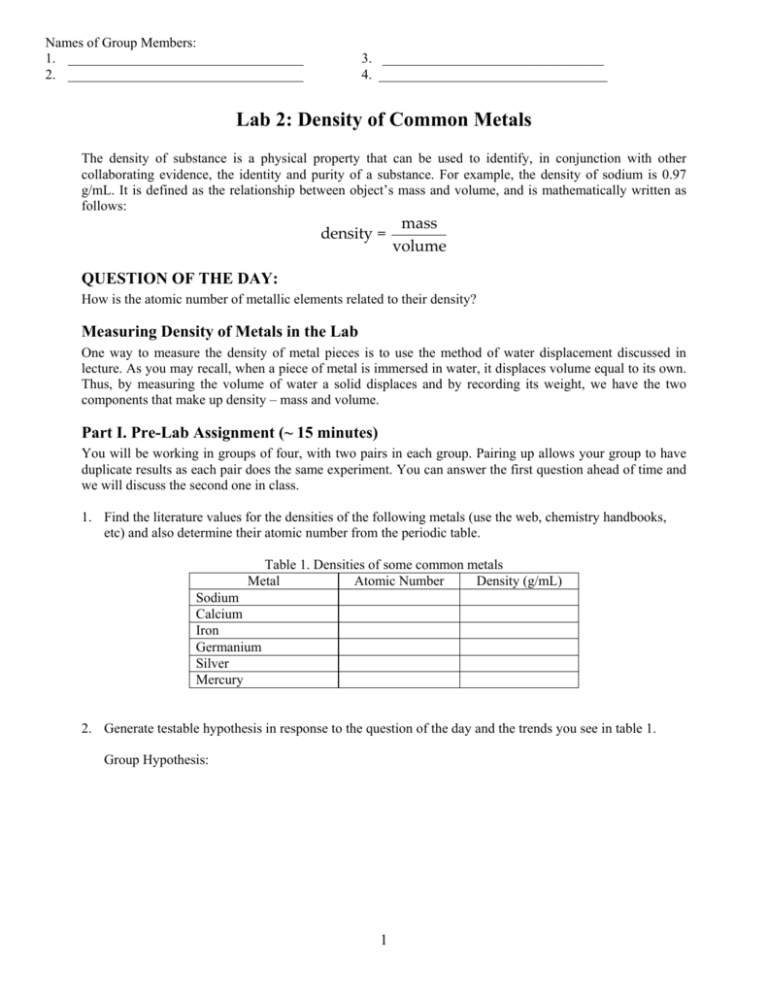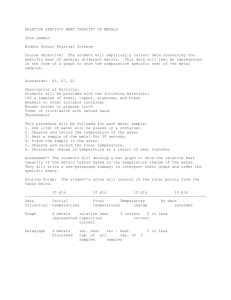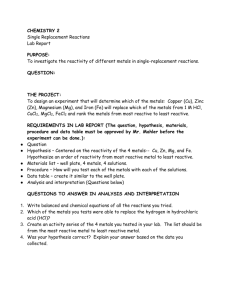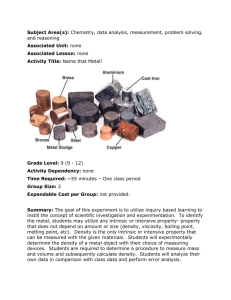Lab 2: Density of Some Common Metals
advertisement

Names of Group Members: 1. __________________________________ 2. __________________________________ 3. ________________________________ 4. _________________________________ Lab 2: Density of Common Metals The density of substance is a physical property that can be used to identify, in conjunction with other collaborating evidence, the identity and purity of a substance. For example, the density of sodium is 0.97 g/mL. It is defined as the relationship between object’s mass and volume, and is mathematically written as follows: density = mass volume QUESTION OF THE DAY: How is the atomic number of metallic elements related to their density? Measuring Density of Metals in the Lab One way to measure the density of metal pieces is to use the method of water displacement discussed in lecture. As you may recall, when a piece of metal is immersed in water, it displaces volume equal to its own. Thus, by measuring the volume of water a solid displaces and by recording its weight, we have the two components that make up density – mass and volume. Part I. Pre-Lab Assignment (~ 15 minutes) You will be working in groups of four, with two pairs in each group. Pairing up allows your group to have duplicate results as each pair does the same experiment. You can answer the first question ahead of time and we will discuss the second one in class. 1. Find the literature values for the densities of the following metals (use the web, chemistry handbooks, etc) and also determine their atomic number from the periodic table. Table 1. Densities of some common metals Metal Atomic Number Density (g/mL) Sodium Calcium Iron Germanium Silver Mercury 2. Generate testable hypothesis in response to the question of the day and the trends you see in table 1. Group Hypothesis: 1 Density of Metals Lab Part II. Experimental Phase (~ 1 hour) You will be given five metals to test your hypotheses. Each pair in your group must determine the density of the metals. Amongst yourself, and with consultations with your instructor, discuss what procedures you can use to determine the density of the metals (5 steps or so). You can use the space below to write your procedures prepare tables for the data you intend to collect (table 2) show your written procedure and prepared table BEFORE performing the measurements prepare summary table (table 3) similar to table 1, with extra column to record actual density values Proposed Procedure (Write down here numbered procedures of what you will do): Table 2: collected data Sample calculation on how you determined density (use calculations of one metal as an example): Table 2: collected data 2 Density of Metals Lab Part III. Post-Lab Questions 1. Did your experimental data support or refute your group’s hypothesis? 2. If your data supported your hypothesis, what accounts for periodic trends you observed? 3. If your data refutes your hypothesis, how else could you explain the observed phenomena in table 1? 3










